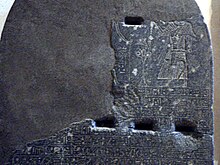Smendes
| Smendes | |||||||||||||||||||||||||||||||||||||||||||||||||||||||||||||||||||||||||||||||||||||||||||||||||||||||||||||||||||||||||||||||||||||||||
|---|---|---|---|---|---|---|---|---|---|---|---|---|---|---|---|---|---|---|---|---|---|---|---|---|---|---|---|---|---|---|---|---|---|---|---|---|---|---|---|---|---|---|---|---|---|---|---|---|---|---|---|---|---|---|---|---|---|---|---|---|---|---|---|---|---|---|---|---|---|---|---|---|---|---|---|---|---|---|---|---|---|---|---|---|---|---|---|---|---|---|---|---|---|---|---|---|---|---|---|---|---|---|---|---|---|---|---|---|---|---|---|---|---|---|---|---|---|---|---|---|---|---|---|---|---|---|---|---|---|---|---|---|---|---|---|---|---|
| Nesbanebdjed, Nesibanebdjedet | |||||||||||||||||||||||||||||||||||||||||||||||||||||||||||||||||||||||||||||||||||||||||||||||||||||||||||||||||||||||||||||||||||||||||
 Canopic jarof Smendes,Metropolitan Museum of Art. | |||||||||||||||||||||||||||||||||||||||||||||||||||||||||||||||||||||||||||||||||||||||||||||||||||||||||||||||||||||||||||||||||||||||||
| Pharaoh | |||||||||||||||||||||||||||||||||||||||||||||||||||||||||||||||||||||||||||||||||||||||||||||||||||||||||||||||||||||||||||||||||||||||||
| Reign | c. 1077/1076–1052 BC[1] | ||||||||||||||||||||||||||||||||||||||||||||||||||||||||||||||||||||||||||||||||||||||||||||||||||||||||||||||||||||||||||||||||||||||||
| Predecessor | Ramesses XI | ||||||||||||||||||||||||||||||||||||||||||||||||||||||||||||||||||||||||||||||||||||||||||||||||||||||||||||||||||||||||||||||||||||||||
| Successor | Amenemnisu | ||||||||||||||||||||||||||||||||||||||||||||||||||||||||||||||||||||||||||||||||||||||||||||||||||||||||||||||||||||||||||||||||||||||||
| |||||||||||||||||||||||||||||||||||||||||||||||||||||||||||||||||||||||||||||||||||||||||||||||||||||||||||||||||||||||||||||||||||||||||
| Consort | Tentamun B | ||||||||||||||||||||||||||||||||||||||||||||||||||||||||||||||||||||||||||||||||||||||||||||||||||||||||||||||||||||||||||||||||||||||||
| Children | Amenemnisu? | ||||||||||||||||||||||||||||||||||||||||||||||||||||||||||||||||||||||||||||||||||||||||||||||||||||||||||||||||||||||||||||||||||||||||
| Mother | probablyHrere | ||||||||||||||||||||||||||||||||||||||||||||||||||||||||||||||||||||||||||||||||||||||||||||||||||||||||||||||||||||||||||||||||||||||||
| Died | 1052 BC | ||||||||||||||||||||||||||||||||||||||||||||||||||||||||||||||||||||||||||||||||||||||||||||||||||||||||||||||||||||||||||||||||||||||||
| Burial | Unknown | ||||||||||||||||||||||||||||||||||||||||||||||||||||||||||||||||||||||||||||||||||||||||||||||||||||||||||||||||||||||||||||||||||||||||
| Dynasty | 21st Dynasty | ||||||||||||||||||||||||||||||||||||||||||||||||||||||||||||||||||||||||||||||||||||||||||||||||||||||||||||||||||||||||||||||||||||||||
Hedjkheperre Setepenre Smendeswas the founder of theTwenty-first Dynasty of Egyptand succeeded to the throne after buryingRamesses XIin Lower Egypt – territory which he controlled. His Egyptiannomenor birth name was actuallyNesbanebdjed[5]meaning "He of the Ram, Lord ofMendes",[6]but it was translated into Greek as Smendes by later classical writers such asJosephusandSextus Africanus.According to theStory of Wenamunfromc. 1000 BC,Smendes was a governor ofLower Egyptduring theEra of the Renaissanceunder the reign ofRamesses XI,however, Egyptologists have questioned the historical accuracy of this story.[7]
Family[edit]
Smendes may have been a son of a lady named Hrere. Hrere was a Chief of the Harem of Amun-Re and likely the wife of a high priest of Amun. If Hrere was Smendes' mother, then he was a brother of Nodjmet and through her brother-in-law of the High PriestsHerihorandPiankh.
Smendes was married toTentamun B,likely a daughter ofRamesses IX.They may have been the parents of his successorAmenemnisu.[8]
Report of Wenamun[edit]
Smendes features prominently in theReport of Wenamun.This story is set in an anonymous "Year 5", generally taken to be year 5 of the so-calledRenaissanceofPharaohRamesses XI,the tenth and last ruler of theTwentieth DynastyofAncient Egypt(1190–1077 BC). However, since Karl Jansen-Winkeln has proposed to reverse the order of theHigh Priests of AmunHerihorandPiankh,this ascription has become disputed.[9]With the pontificate of Herihor falling later than that of Piankh, who is attested in year 7 of the Renaissance,[10]the date in the heading of Wenamun should rather refer to the successor of Ramesses XI. Following Jansen-Winkeln, Arno Egberts (1991) therefore argues that the story is set in the fifth regnal year of Smendes.
As the story begins, the principal character, Wenamun, a priest ofAmunatKarnak,is sent by theHigh Priest of AmunHerihorto thePhoeniciancity ofByblosto acquire lumber (probablycedarwood) to build a new ship to transport thecult imageof Amun. Wenamun first visits Smendes atTanisand personally presented his letters of accreditation to Smendes in order to receive the latter's permission to travel north to modernLebanon.Smendes responds by dispatching a ship for Wenamun's travels toSyriaand theLevant.Smendes appears as a person of the highest importance in Tanis.
Reign[edit]

Smendes' nominal authority over Upper Egypt is attested by a single inscribed stela found in a quarry at Ed-Dibabiya, oppositeGebeleinon the right bank of the Nile, as well as by a separate graffito inscription on an enclosure Wall of theTemple of Monthu at Karnak,the Temple that was originally constructed during the reign ofThutmose III.[11]
The quarry stela describes how Smendes "while residing in Memphis, heard of danger to the temple of Luxor from flooding, gave orders for repairs (hence the quarry works), and received news of the success of the mission."[12]
Smendes is assigned a reign of 26 Years byManethoin his Epitome.[13]This figure is supported by the Year 25 date on theBanishment Stelawhich recounts that the High PriestMenkheperresuppressed a local revolt in Thebes in Year 25 of a king who can only be Smendes because there is no evidence that the High Priests counted their own regnal years even when they assumed royal titles likePinedjem Idid.[14]Menkheperre then exiled the leaders of the rebellion to the Western Desert Oases. These individuals were pardoned several years later during the reign of Smendes' successor,Amenemnisu.
Smendes ruled over a divided Egypt and only effectively controlled Lower Egypt during his reign while Middle and Upper Egypt was effectively under the suzerainty of the High Priests of Amun such asPinedjem I,Masaharta,andMenkheperre.Hisprenomenor throne nameHedjkheperre Setepenre/Setepenamun—which means 'Bright is the Manifestation ofRê,Chosen of Rê/Amun'[4]—became very popular in the following22nd Dynastyand23rd Dynasty.In all, five kings:Shoshenq I,Shoshenq IV,Takelot I,Takelot IIandHarsiese Aadopted it for their own use. On the death of Smendes in 1052 BC, he was succeeded byNeferkare Amenemnisu,who may have been this king's son.
No trace has yet been found of the tomb of Smendes. The sole funerary object linked to Smendes is aCanopic jarof his, that once contained his liver, that currently resides in theMetropolitan Museum of Art(acc. no. 47.60). This may indicate his tomb was looted in antiquity, but this hypothesis is unproven.[citation needed]
References[edit]
- ^R. Krauss & D.A. Warburton "Chronological Table for the Dynastic Period" in Erik Hornung, Rolf Krauss & David Warburton (editors),Ancient Egyptian Chronology(Handbook of Oriental Studies), Brill, 2006. p. 493
- ^Clayton, Peter A.Chronicle of the Pharaohs.Thames & Hudson. 2006. p. 178
- ^Digital Egypt for Universities
- ^abClayton, p. 178
- ^Nesbanebdjed
- ^Mansikka, Pekka (2020).New Chronology Using Solar Eclipses, Volume III.p. 180.ISBN978-9528023142.
- ^Hagens, Graham (1996). "A Critical Review of Dead-Reckoning from the 21st Dynasty".Journal of the American Research Center in Egypt.33.American Research Center in Egypt: 156.doi:10.2307/40000612.ISSN0065-9991.JSTOR40000612.
- ^Aidan Dodson & Dyan Hilton,The Complete Royal Families of Ancient Egypt,Thames & Hudson (2004)ISBN0-500-05128-3,pp. 196-209
- ^Karl Jansen-Winkeln, "Das Ende des Neuen Reiches",Zeitschrift für ägyptische Sprache,119 (1992), pp.22-37
- ^Nims,Journal of Near Eastern Studies,7 (1948), 157-162
- ^J. Cerny, "Egypt from the Death of Ramesses III to the End of the Twenty-First Dynasty" inThe Middle East and the Aegean Region c. 1380-1000 BC,Cambridge University Press, p. 645ISBN0-521-08691-4
- ^K.A. Kitchen,The Third Intermediate Period in Egypt (1100-650 BC),3rd ed. (Warminster: Aris & Phillips, 1996), p. 256
- ^Manetho, fragments 58 & 59; translation in W.G. Waddell,Manetho(Cambridge: Harvard University, 1997), pp. 155-7ISBN0-674-99385-3
- ^Kitchen, p. 260
Further reading[edit]
- G. Daressy, "Les Carrières de Gebelein et le roi Smendés",Receuil de Travaux Relatifs à la Philologie et à l’Archeologie Égyptiennes et Assyriennes,10 (1988) 133–8.
- Nicolas Grimal,A History of Ancient Egypt,Blackwell Books (1992)

